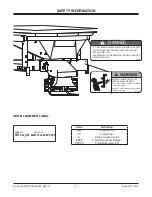
Lit. No. 43573/43583/43593, Rev. 01
8
August 15, 2013
LOADING
DETERMINING VEHICLE PAYLOAD
1. Install the hopper spreader and optional
equipment according to the instructions.
2. Install or attach any other equipment that will be
on the vehicle while the hopper spreader will be in
use (step bumper, trailer hitch, snowplows, etc.).
Fill gas tanks.
3. Obtain the Gross Vehicle Weight Rating (GVWR),
Front Gross Axle Weight Rating (FGAWR) and
Rear Gross Axle Weight Rating (RGAWR) from
the certi
fi
cation label located inside the driver-side
door jamb or door.
4. With the occupants in the truck for normal hopper
spreader operation, weigh the vehicle to obtain
gross vehicle weight (GVW).
5. Subtract the GVW from the GVWR to determine
the available material payload.
6. Obtain the weight per cubic yard (lb/cu yd) of
the desired material. Divide the weight into the
payload to determine the maximum volume of
material that can be carried.
WARNING
Overloading could result in an accident or
damage. Do not exceed GVWR or GAWR
ratings as found on the driver-side door
cornerpost of the vehicle. See Loading
Section to determine maximum volumes of
spreading material.
7. Compare the maximum volume to determine the
maximum height of the material in the hopper
spreader.
8. Fill the hopper with the material to the calculated
height. Reweigh the vehicle with occupants
and verify the GVW, Front Gross Axle Weight
and Rear Gross Axle Weight are less than the
vehicle's ratings.
9. Repeat Steps 7 and 8 for each type of material.
Material
Density
(lb/ft
3
)
Rock Salt
– Dry
80–90
Sand/Salt Mix
– Dry
95–120
WARNING
Do not overload vehicle. Use chart below
to calculate weight of material. Weights of
material are an average for dry materials.
CAUTION
Never use wet materials or materials with
foreign debris with any of these spreaders.
These units are designed to handle dry, clean,
free
fl
owing material.
Содержание POLY-CASTER
Страница 2: ......




































